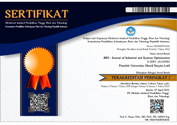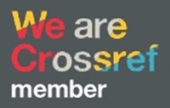ANALISA PENERAPAN SISTEM MANAJEMEN KESELAMATAN DAN KESEHATAN KERJA MENGGUNAKAN METODE HIRARC DI PT. AGR UNIT ARF
DOI:
https://doi.org/10.51804/jiso.v5i2.106-112Keywords:
SMK3, APD, HIRARCAbstract
ABSTRAK
Penerapan Sistem Manajemen Keselamatan dan kesehatan Kerja (SMK3) di PT. AGR Unit ARF sudah cukup baik, dengan diterapkannya standar Alat Pelindung Diri (APD) untuk setiap lokasi kerja, setiap beberapa bulan juga dilakukan pengecekan kondisi lingkungan dan dilakukan efaluasi terkait ketidak sesuaian yang terjadi. Menurut data kecelakaan kerja PT. AGR Unit ARF pada tahun 2016 sampai dengan tahun 2021 tercatat sudah terjadi 15 kecelakaan kerja, mulai dari kecelakaan kerja ringan seperti tersayat pisau sampai dengan kecelakaan fatal yang menyebabkan cacat permanen, Hal ini membuktikan bahwa sistem manajemen K3 yang ada belum mencapai zero accident. untuk itu penelitian ini bertujuan melakukan pengamatan dan analisis terhadap penerapan komitmen penerapan sistem manajemen keselamatan dan kesehatan kerja pada PT. AGR unit ARF. Metode yang akan digunakan dalam penelitian ini adalah metode HIRARC untuk mengidentifikasi resiko pada lingkungan kerja di PT. AGR unit ARF yang dapat merugikan manusia, lingkungan, dan sistem yang ada. Hasil dari penelitian ini adalah terdapat 36 risiko kerja yang ada pada area produksi PT. AGR unit ARF dengan 4 kategori risk rating, yaitu Extreme risk, Hight risk , Medium risk , Low risk. Terdapat 1 proses pekerjaan yang dikategorikan sebagai Extreme risk, 5 proses pada kategori Higt Risk, 12 risiko pada Medium risk, dan 18 risiko pada Low risk. Sedangkan pengendalian risikonya menggunakan metode Hirarki (Hierarchy of control), yaitu dengan melakukan eliminasi, subtitusi, administrasi, training, dan penambahan APD (Alat Pelindung Diri).
ABSTRACT
Implementation of Occupational Safety and Health Management System (SMK3) at PT. AGR The ARF unit is quite good, with the implementation of the standard Personal Protective Equipment (PPE) for each work location, every few months environmental conditions are also checked and an evaluation is carried out regarding any discrepancies that occur. According to work accident data, PT. AGR Unit ARF in 2016 to 2021 recorded 15 work accidents, ranging from minor work accidents such as knife cuts to fatal accidents that cause permanent disability, this proves that the existing K3 management system has not reached zero accident. For this reason, this study aims to observe and analyze the implementation of the commitment to the implementation of an occupational health and safety management system at PT. AGR of ARF units. The method that will be used in this research is the HIRARC method to identify risks in the work environment at PT. AGR ARF units that can harm humans, the environment, and existing systems. The results of this study are there are 36 work risks that exist in the production area of PT. AGR unit ARF with 4 risk rating categories, namely Extreme risk, High risk, Medium risk, Low risk. There is 1 work process which is categorized as Extreme risk, 5 processes in the High risk category, 12 risks in Medium risk, and 18 risks in Low risk. While the risk control uses the Hierarchy of control method, namely by eliminating, substitution, administration, training, and adding PPE (Personal Protective Equipment).
References
Asiah, N. (2020). Evaluasi Penerapan Sistem Manajemen Keselamatan dan Kesehatan Kerja (SMK3) di Rumah Sakit Umum Daerah dr. Zainoel Abidin Banda Aceh. UIN AR-RANIRY.
Darmawan, D., Puspita, A. D., & Santosa, G. (2022). ANALISIS KESELAMATAN DAN KESEHATAN KERJA DENGAN PENDEKATAN HAZARD IDENTIFICATION RISK ASSESSMENT AND FAULT TREE ANALYSIS PADA PT. WGI. JISO: Journal of Industrial and Systems Optimization, 5(1), 10-17.
Indonesia, P. R. (2012). Peraturan Pemerintah Republik Indonesia Nomor 50 Tahun 2012 Tentang Penerapan Sistem Manajemen Keselamatan dan Kesehatan Kerja. Sekretariat Negara, Jakarta.
Muhtia, S. A., Fachrin, S. A., & Baharuddin, A. (2020). Analisis Risiko Keselamatan dan Kesehatan Kerja dengan Metode HIRARC (Hazard Identification, Risk Assesment, Risk Control) pada Pekerja PT. Varia Usaha Beton Cabang Makassar. Window of Public Health Journal, 166–175.
Pakereng, R., & Wijaya, H. S. (2019). Evaluasi Penerapan Sistem Manajemen Keselamatan dan Kesehatan Kerja pada Pekerjaan Gedung Apartemen Begawan Malang. Prosiding SENTIKUIN (Seminar Nasional Teknologi Industri, Lingkungan Dan Infrastruktur), 2, D11-1.
Setyowati, D. L. (2018). Hubungan Pengetahuan, Sikap, Pelatihan, Pengawasan Dengan Persepsi Tentang Penerapan SMK3. Faletehan Health Journal, 5(1), 19–24.
Yenni, M., Harahap, P. S., & Sutanoto, P. (2019). Analisis penerapan Sistem Manajemen Keselamatan dan Kesehatan Kerja (SMK3) di PT Remco Jambi tahun 2018. Riset Informasi Kesehatan, 8(1), 63–69.
Downloads
Published
Issue
Section
License
With the receipt of the article by JISO Editorial Board and the decision to be published, the copyright regarding the article will be transferred to JISO. The copyright transfer form can be downloaded here.
JISO has the right to multiply and distribute the article and every author is not allowed to publish the same article that was published in this journal.
JISO is licensed under a Creative Commons Attribution-ShareAlike 4.0 International License.
Under the following terms:
Attribution — You must give appropriate credit, provide a link to the license, and indicate if changes were made. You may do so in any reasonable manner, but not in any way that suggests the licensor endorses you or your use.
ShareAlike — If you remix, transform, or build upon the material, you must distribute your contributions under the same license as the original.














